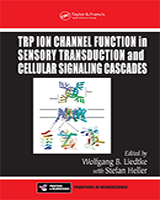TRP Ion Channel Function in Sensory Transduction and Cellular Signaling Cascades
Frontiers in Neuroscience
Editors
Editors: Wolfgang B Liedtke1 and Stefan Heller2.Affiliations
TRP ion channels were first described in Drosophila melanogaster in 1989 and in mammals several years later. In 1997, TRPV1, a member of the TRP channel superfamily (now with more than 60 members in vertebrates and invertebrates but not in bacteria and plants), was described to respond to the pungent ingredients of hot pepper, then named capsaicin receptor. Ever since we have witnessed an explosion of activity in this field of scientific inquiry for obvious reasons. TRP ion channels are critical elements in signal transduction of cellular signaling cascades and of neurosensory processes, which are involved in all five senses.
This book, TRP Ion Channel Function in Sensory Transduction and Cellular Signaling Cascades presents 31 chapters written by researchers who have made these key discoveries, such as Dr. Lutz Birnbaumer who discovered mammalian TRP channels, and who continues to conduct TRP ion channel research at the cutting edge of this hyperdynamic area. Because of the burgeoning nature of the field, this book does not represent an all-comprehensive view on TRP channel biology. However, it does shed light on selected topics of outstanding interest in the TRP arena, such as signal transduction in axonal pathfinding, and vascular, renal, auditory, and nociceptive functioning, to name a few, and the spotlight is cast by an international cast of outstanding chapter authors.
Series editors: Sidney A Simon and Miguel AL Nicolelis
This book contains information obtained from authentic and highly regarded sources. Reprinted material is quoted with permission, and sources are indicated. A wide variety of references are listed. Reasonable efforts have been made to publish reliable data and information, but the author and publisher cannot assume responsibility for the validity of all materials or the consequences of their use.
